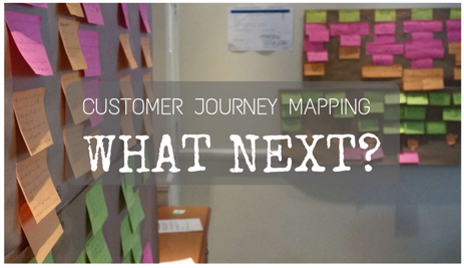Customer Journey Mapping, done. What next?
Here’s a familiar scenario in the customer journey mapping process. Your workshops went well, everyone was engaged and the team is bursting with ideas. You added extra value by creating an environment where people from across all functions shared their behind-the-scenes stories. In doing so they learned a lot more about their own business, which wouldn’t have happened without you. All in all it’s a good result.
With plenty of actions and food for thought there is now momentum. Expectations are high but the ‘journey of the journey’ has only just begun. So as you unplug your laptop, switch off the light and leave the workshop your attention turns to what happens next.
In the first part of this series I explored ways to get buy-in from skeptical stakeholders for customer journey mapping workshops. Last time I looked at how to make sure the workshop stays on track and is efficient use of time. And for this last instalment I want to share thoughts on what to do after everyone’s gone back to their day job.
And that’s part of the challenge we now face. We’ve got people interested and we’ve flushed out some great initiatives. However, the reality is that whatever gold we uncover and however energised we feel, we have to make it part of their day job before the wave of enthusiasm loses its energy. We don’t want it lost in the noise of inboxes and meetings.
A large utility company I worked with recently told me they’d done some journey mapping a couple of years previously. They’d had it illustrated and they’d dig it out to compare then with now. Only they couldn’t find it. After much searching the mystery was eventually uncovered. In a sea of hot-desks at corporate HQ was a line of table-high storage units. Beneath the glass top, but also barely visible under stationery boxes, photocopying paper and a guillotine was a cleverly illustrated customer journey. Had it been on show it would have been a powerful way to engage stakeholders. It told a compelling story and could have been a catalyst for badly needed change. But all the effort had, literally, been shelved.
So what can we do to make sure the path down which we’ve just started doesn’t wind on aimlessly? Here is my take on just some of things we can do.
Share it
First things first, thank everyone for attending and write up the journey (s) you’ve looked at. Beyond that, share it personally with other stakeholders who you need to be involved and demonstrate the momentum you now have, inviting them to be part of it. Get everyone to share the outputs with their own teams and make it part of the governance process to have them reviewed and critiqued.
Sharing it widely increases the collective ownership. It will also then keep evolving into a more accurate picture of the real-world customer experience.
Show it off
Customer journey mapping isn’t, as some organisations seem to think, all about creating a pretty picture. It’s important but not the end-game, far from it. What it looks like will depend on what works for your own business and who your audiences are. Some will be at a high-level and others more detailed but if you can turn the brown paper and sticky notes into something pleasing to the eye that’s great. Make it large and put it somewhere that will stay visible. Ask passers-by in the office to comment on it.
Unless you have easy access to a graphics team, my experience is that, at worst, it’s better to have a well-organised table made in PowerPoint, Keynote or Excel to tell the tale than to lose time trying making it look like a storyboard for the next Peter Jackson film. The aim is still to help colleagues understand what they need to change and why.
Validate it
When you feel it’s in good shape, try it out on a few customers who match the persona from whose perspective it was done. Ask them if they recognise that as their journey and their issues as they pass through it. Play it back to them so they know you’ve understood and ask them what they don’t want to happen at each stage. Having that extra layer of customer validation gives enormous credibility, something that’s hugely beneficial when dealing with stakeholders, especially the one who love to pick holes in things.
Act on it
It’s the most obvious and important thing to do with a journey map but there’s simply no point in doing the maps if there’s no way of using them. It must become a regular feature of the CX governance. Or, as I’ve seen a few times, the creation of a journey map is the very stimulus needed for creating oversight in the first place. The maps need nurturing and harvesting if they are to continue growing and yielding more insights.
Prioritising what to do next is then the issue. Hopefully you’ll have no shortage of possible actions but the mapping exercise will reveal what to do first. You will have identified what’s most important and how well it’s done and that then gives confidence about what to do in the short, medium and long term for customers, colleagues and stakeholders.
Picking off those things that are easy to implement and have a big impact will also demonstrate the proof of concept for when you are seeking greater investments in time, people and money.
Do more of it
It’s not a one-off exercise. The world keeps changing so the mapping will need repeating to stay relevant. That might be at least annually if not more frequently, especially as your changes get implemented and the experience evolves. Even if nothing within the front-line business changes, customers’ expectations shift, competitors up the ante and an IT systems upgrade always seems to have an unintended consequence somewhere down the line.
It’s likely you identified several other personas in the workshop so map the same journey for them. You’ll also have different journeys, some made by yet more personas, to map out too. And time spent mapping what it’s like for a colleague and/or third-party to deliver the experience is as invaluable as it is necessary to complete the picture.
The customer journey mapping process is an essential competency of any business. It’s only part of the CX mix and without it the risks, wasted costs and commercial consequences can be significant.
But with the right engagement and preparation, with robust facilitation and with the resilience to build the momentum you’ve created, your influence will be greater, the connection between CX and the bottom-line will be clearer and the cogs of the business all fit together neatly to deliver the right experiences. A good result indeed.
Follow Jerry Angrave on Twitter @jerryangrave
Thank you for reading the blog about journey mapping, I hope you found it useful. I’m Jerry Angrave, a Certified Customer Experience Professional (CCXP). I’m a  CX consultant with an extensive corporate background and I also specialise in professional development for those in, or moving to, customer experience roles. Feel free to contact me with any questions – by email to [email protected] or by phone on +44 (0)7917 718072. More details at the website www.empathyce.com.
CX consultant with an extensive corporate background and I also specialise in professional development for those in, or moving to, customer experience roles. Feel free to contact me with any questions – by email to [email protected] or by phone on +44 (0)7917 718072. More details at the website www.empathyce.com.

This is all very well but it doesn’t give the specific details about the next steps. Ie, how to get ownership of an action, how to check in on progress, how to identify clear success metrics. It would be great to understand more about that.
Thanks Anelea, you make a good point about the governance as journey mapping is pointless without the next step. How organisations do that will vary depending on their culture, their appetite for change, whether they have a CX strategy in place to guide them and so on. It’s a huge topic in its own right and though I referred to it in the post I didn’t want to swamp the journey mapping subject. On the topic of governance you may be interested in these couple of articles, one from McKinsey (https://www.mckinsey.com/business-functions/operations/our-insights/designing-and-starting-up-a-customer-experience-transformation) and this one from Bruce Temkin (https://experiencematters.blog/resources-cx-maturity-level-4-operationalize/) which focuses on operationalising CX but is part of a broader view of the CX maturity model. You will also find more on governance as a key competency at the CXPA’s website http://www.cxpa.org. I hope that is of some help. All the best, Jerry
Hi Jerry,
Thanks for the blog, what happens next once we have captured the output of the customer journey session. We validate that with the stakeholders/ PO’s.
My question is how does this connect to the end deliverable as EPIC/ Features/ user stories?
Thanks John, the validation process with customers will challenge or reinforce what you have done so far to create the journey map. Asking them what they think of it will lead to them sharing their stories about what it was really like. They will talk about their own experiences to explain how accurate (or not) the journey map is. That in turn helps bring it all to life for your stakeholders and can refine the changes you make as a result. Does that answer your question?